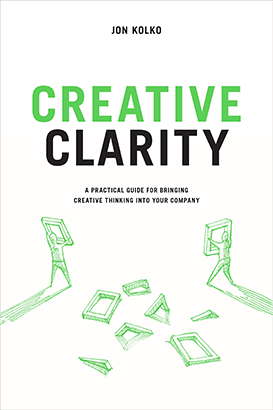
This is from 2012 | 5 minute read
How Do You Transform Good Research Into Great Innovations?
Overview
You've just completed design research in the field, capturing hours of video, thousands of photos, artifacts, papers, and documents. And now, you're stumped and overwhelmed. What should you do next? How do you do it? And how do you know when you've done a good job?
Design synthesis—the process of translating data and research into knowledge—is the most critical part of the design process. Yet in our popular discussions of design and innovation, we've largely ignored this fundamental role. We engage in debates and discussions about process methodologies (waterfall vs. agile, user-centered design vs. technology-driven design) and management techniques (topgrading, negotiation), yet we rarely engage in conversation about incubation and translation: making meaning out of the data we've gathered from research, as we strive for innovation. It's as if this part of design is magical, and for us to formalize our techniques would somehow call attention to our sleight of hand.
Without a formal strategy and approach to synthesis, experienced designers rely on their intuition, built up over years of trial and error. "Just trust me," says the old-guard, and the discipline of design loses credibility. Worse, younger designers flail and waste precious time, becoming frustrated and ultimately rejecting the ethnographic research methods themselves. Yet it isn't the research methods that are at fault, as research itself does not produce new ideas. The approaches to incubation and translation can be formalized, and to do so offers a great service to designers who are struggling to work through increasingly complicated problems in business and culture. During design synthesis, truly revolutionary innovations emerge.
Focusing on Activity and Action
Most of us engaged in large-scale design efforts agree that ethnographic research is required to build empathy and understanding. Yet immediately after research has been conducted, a period of complacent inaction emerges. The team is overwhelmed, and without a clear indication of what to do next, they sit, idle, sifting through the transcripts and video with no rhyme or reason to their method. In my experience, clients—reacting to this inaction—dismiss the entire value of research at all. Similarly, creative directors—frustrated with a lack of forward movement—often circumvent process and rely on their personal experiences, doing whatever worked well last time, again. Precious time is lost; ideas become flat and tired; the team tends towards inertia. Here are three tactics to overcome this inertia.
1. Get out of the laptop
The data created or gathered from contextual research will often take many forms: photographs, video clips, transcripts, requirements lists, magazine clippings, and other artifacts related to the problem. In an effort to maintain some sense of coherence, we'll frequently horde the data in our laptops. The digital format lets us easily organize ourselves around files, folders, wikis and databases. But the file structure also arbitrarily limits the ability to manipulate individual pieces of data freely across file types, to form connections between pieces of data, and to manipulate the data quickly. The physical limitation of the laptop (the size), combined with the digital limitations of the software (the organizational schema), dramatically limits our ability to understand the research in totality. Externalize the data through a process of spatialization. This is the quintessential (and unfortunately overplayed) image of the designer moving Post-it notes around (typically on a glass wall, and usually photographed through frosted glass with a dramatic depth of field). Each Post-it contains a piece of data. A week of research will generate thousands of data points. Take the time to rigorously move from a digital medium to the physical world.
2. Identify and celebrate patterns and anomalies
As your data is now quite literally all around you, methodically identify relationships between customer utterances, feature requests, technical constraints, and other data points. These relationships are hidden in the data, and it's up to you and your team to identify them; the unique disciplinary makeup of the team will determine the lens through which you examine each data point. Quite literally, compare note 1 and note 2, and if they are related, place them next to each other. Repeat this, through several passes, over the entire room. Time-box the exercise based on your schedule; when you are done, look carefully at patterns you've discovered, as these can begin to articulate opportunities for "low-hanging fruit" or "quick hits". But don't discard the extreme outliers, either—as these articulate opportunities for dramatic and radical innovation.
3. Build a model of something, anything
A model is a visual representation of an idea; we use models to understand, and to communicate, and to simplify. Build a model of your data. Start with circles and arrows, and connect noun and verb pairs. Identify existing or potential work flow changes, and map them in a process flow. Extract the power dynamics implicit in any human system (literally, the people who hold the power, and whom they hold it over), and make a chart of this data. Because these are thinking tools, tools for synthesis, there's only one wrong way to do this: not doing it at all. Looking at the data and talking about the data doesn't count. If it isn't modeled, written, drawn, and otherwise solidified in an artifact, it never happened.
These tactics are fundamental for making sense of gathered research data, in order to move from data to information. This is the beginning of synthesis: Making meaning of data in order to produce new, compelling, and appropriate innovations. These tactics can be applied to the design of new products, both physical and digital, and to business process problems, systems and services, and even to complicated issues of channel optimization, go-to-market strategies, and other complication core business issues.
This is part one in a Fast Company series; you may also enjoy reading parts two and three.
